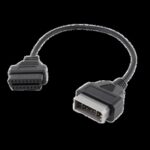The OBD2 port in modern vehicles, including those with Ecoboost engines, is a gateway to your car’s computer system. It’s designed for diagnostics and monitoring, but it’s also increasingly used for aftermarket devices. While some of these devices offer convenience or security, it’s crucial to understand the potential risks involved, especially concerning your vehicle’s sensitive electronics.
Dealerships sometimes install aftermarket options like LoJack as add-ons. Even if you decline the service, these devices might remain connected to your vehicle’s systems. These installations often tap into the OBD2 port for power and data. While a simple two-wire connection might seem harmless, drawing power from the OBD2 port, even for devices like LoJack, can introduce unexpected issues. It’s essential to be aware of any non-factory equipment installed on your vehicle, as they can sometimes lead to unforeseen problems.
One forum user shared a personal experience highlighting the sensitivity of modern car electrical systems. Initially attempting a simple wiring modification for rear lights on a newer truck, they tapped into existing circuits for power. This seemingly minor modification resulted in setting a Body Control Module (BCM) Diagnostic Trouble Code (DTC) due to overcurrent. Locating and clearing the DTC required time and research, underscoring that even experienced individuals can encounter issues with modern vehicle electronics.
Modern vehicles, including those equipped with Ecoboost engines, utilize very thin gauge wiring. This is a significant departure from older vehicles with thicker wiring. Using traditional crimp connectors on these thinner wires can create increased resistance. While connections might initially seem functional, they can lead to long-term problems, intermittent issues, and the triggering of DTCs. These issues can manifest as unexpected system shutdowns or erratic behavior.
While OBD2 port dongles might appear to be a safer alternative compared to direct wire tapping, they are not without risk. Drawing excessive power through the OBD2 port can still overload internal networks and trigger DTCs. The car’s computer system is designed to detect even minor anomalies in electrical current and will respond accordingly. Therefore, even seemingly low-draw OBD2 devices need to be considered carefully.
In conclusion, while the OBD2 port offers convenient access for aftermarket devices in your Ecoboost vehicle, it’s important to proceed with caution. Understanding the sensitivity of modern electrical systems, the potential for DTCs, and the nuances of thin gauge wiring is crucial. Always ensure any aftermarket installations are done correctly and with consideration for your vehicle’s delicate electronics to avoid unexpected problems and maintain optimal performance.
